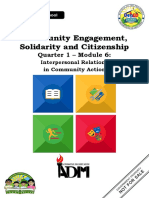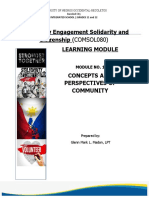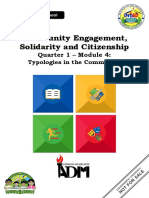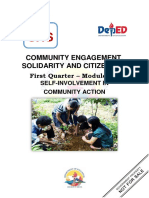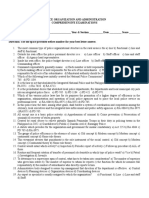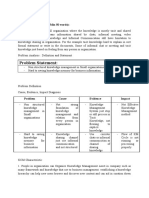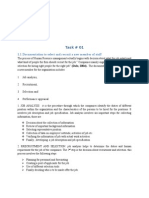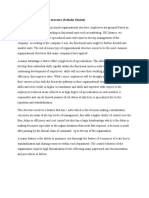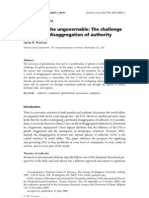SHS
COMMUNITY ENGAGEMENT,
SOLIDARITY AND CITIZENSHIP
Second Quarter – Module 6:
PLAN USING PARTICIPATORY
APPROACHES
i
�Community Engagement, Solidarity and Citizenship
Quarter 2 – Module 6: Plan Using Participatory Approaches
Republic Act 8293, section 176 states that: No copyright shall subsist in any work of
the Government of the Philippines. However, prior approval of the government
agency or office wherein the work is created shall be necessary for exploitation of
such work for profit. Such agency or office may, among other things, impose as a
condition the payment of royalties.
Borrowed materials (i.e., songs, stories, poems, pictures, photos, brand names,
trademarks, etc.) included in this book are owned by their respective copyright
holders. Every effort has been exerted to locate and seek permission to use these
materials from their respective copyright owners. The publisher and authors do not
represent nor claim ownership over them.
Regional Director: Gilbert T. Sadsad
Assistant Regional Director: Jessie L. Amin
Development Team of the Module
Writer: Alma Theresa D. Diaz
Evaluator: Raymund S. Briones
Editor: Divina M. Diaz, Ph.D.
Marita H. Mendoza
Illustrator:
Layout Artist: Edsel D. Doctama
ii
�INTRODUCTION
The unit of competency, "Plan using participatory approaches", is one of the
competencies of Community Engagement, Solidarity, and Citizenship, a course
which comprises the knowledge, skills and attitudes required for a HUMMS graduate
to possess. The module will introduce to you the participatory approach in
community action plan, its advantages and disadvantages as well as the levels of
participatory planning and its processes.
OBJECTIVES
Your learning will be successful if at the
end of this module, you will be able to:
a. explain what participatory approach in community action plan is;
b. identify the importance, steps, and guidelines of participatory action
planning;
c. make a community action using participatory approaches.
VOCABULARY LIST
To guide you in the module there are some words
and phrases that you need to know before you start:
Plan - design or something to be made or built
Participatory - characterized by or involving participation especially
in providing the opportunity for individual participation
1
�Participatory Approaches – identify the participation or role of an individual, group
of persons or social institution in community development
Partnership - it implies a relationship of equals, where everyone has an equal
voice, and where power and responsibility are equally shared
Reflexivity - generally refers to the examination of one's own beliefs,
Judgements and practices during the research process and
how these may have influenced the research
Stakeholder - a person with an interest or concern in the community
PRE-TEST
Let me see if you are ready
for this module. Take time
to answer the pre-test.
Instruction: Read and understand each sentence carefully. Choose the letter of
best answer that agrees with the statement.
1. It is essential and strategic for any organization or community.
A. Planning
B. Action
C. Participate
D. A & B
2. Participatory approach in community action plan will fail if there is,
A. Lack of participation
B. No action Plan
C. Few resources
D. Less manpower
2
� 3. Which is not a level of participatory approach in planning?
A. Information
B. Deciding Together
C. Consultation
D. Targets of change
4. He/ She believes that humans have equal rights and dignity that can be used
for social change and development.
A. Stakeholder
B. Leader
C. Facilitator
D. Member
5. The following are advantages of participatory planning process, except
A. It implies respect for everyone in the community
B. It is effective
C. A participatory process takes longer
D. It builds trust
LEARNING ACTIVITIES
In module 5, you identified the major issues existing in the
community and learned how to formulate community action
plan that will address the community issues. Enrich your
knowledge by learning more about participatory approach.
A participatory approach helps to secure the ownership and commitment of
the communities involved. Active participation by local citizens and other stakeholders
aims to enhance both the quality and relevance of the suggested interventions.
Implementation Stage is when the planned intervention is implemented.
3
� Participatory planning is an urban planning paradigm that emphasizes
involving the entire community in the strategic and management processes of urban
planning; or, community-level planning processes, urban or rural. It is often considered
as part of community development. Participatory planning aims to harmonize views
among all of its participants as well as prevent conflict between opposing parties. In
addition, marginalized groups have an opportunity to participate in the planning
process
Planning is essential and strategic for any organization or community. With
planning, organizations and communities become reflexive, dynamic, responsive, and
systematic.
In order for planning to become participatory in nature, there must be an
ongoing process wherein the participants and stakeholders engage dynamically in
identifying the community’s situations, needs and resources, goals and objectives, and
strategies; in outlining activities for implementation; in setting time frame and duration;
and in allocating resources.
The important thing to remember here is the word participatory. The use of that
term implies not just that you'll ask for someone's opinion before you do what you were
going to do anyway, but rather that each participant becomes an important contributor
to the planning process.
A true participatory approach is one in which everyone's perspective is
considered. That doesn't mean that people can't challenge others' assumptions, or
argue about what the best strategy might be. It does mean, however, that everyone's
thoughts are respected, and it isn't necessarily assumed that the professionals or the
well -educated automatically know what's best. Everyone actually gets to participate
in the planning process, and has some role in decision-making.
4
�The participatory approach involves:
♦ sharing of knowledge and
BIG IDEAS
Many low-income or minority
experience
individuals and groups feel that they
♦ recognizing and encompassing have no voice in the society, that they
different perspectives are not heard even when they are
asked for their opinions. True
♦ working in teams on practical
participation means that everyone has
tasks a voice which must be acknowledged.
♦ the use of visualization and Acknowledgment also implies having
analytical tools, imagination and enough respect for another's opinion
to argue with it. All too often, low-
drama
income or minority members of a
♦ an open-ended creative learning planning team or governing board are
process treated with reverse condescension,
as if anything they say must be true
♦ the development of shared
and profound. A truly participatory
understanding and jointly owned process would include not only
plans or other products everyone being heard, but also
everyone thrashing out ideas and
♦ the capacity for reflection and
goals, and wrestling with new
self-assessment concepts.
In order for this to happen, those with
ADVANTAGES OF PARTICIPATORY
less education and "status" often need
PLANNING APPROACH extra support, both to learn the
Participation carries with it process and to believe that their
opinions and ideas are important and
feelings of ownership, and builds a
worth stating. All of this takes time, but
strong base for the intervention in the the rewards are great.
community. If people are integral to the
planning of a community intervention, then that intervention will be theirs. They have
5
�a stake in it not only as its beneficiaries or staff or sponsors, but as its originators. They
will do what they can, to see their work succeed.
It ensures that the intervention will have more credibility in all segments of the
community because it was planned by a group representing all segments of the
community. If people know that others with the same point of view and experience as
theirs were instrumental in making the intervention happen, they'll assume that their
interests were attended to.
A participatory planning approach avoids pitfalls caused by ignorance of the
realities of the community or the target population. If, for instance, Muslims are part of
the planning process for an intervention in a community which includes many followers
of Islam, they'll know that lunch meetings during Ramadan, the Islamic month of
daytime fasting, are not likely to work. Long-time community members will know what
has failed in the past, and why, and can keep the group from repeating past mistakes.
It involves important players from the outset. If the intervention needs the
support of a particular individual, or that of a particular agency or group, and they've
been part of the planning from the beginning, their cooperation is assured.
It can provide an opportunity for often-disenfranchised groups to be heard, and
teach the community that they have important things to say.
It teaches skills which last far beyond the planning process, and can help to
improve the community over the long term. People learn to run meetings, to analyze
data, to construct strategic plans - in short, to become community resources and
leaders.
It can bring together and establish ties among community members who might
normally have no contact. Such relationships - between low-income people and
6
�business leaders, for instance - are not only supportive of the intervention, but may
help to create long-term relationships and break down barriers in the community.
A participatory planning process builds trust, both between your organization
and the community and among the individuals involved. This trust can serve as a
foundation for future community development and community action.
A participatory planning process generally reflects the mission and goals of
grass roots and community-based organizations. With its underpinnings of
collaboration, inclusiveness, and empowerment, a participatory approach embodies
the ideals that form the foundations of most grass roots and community-based
organizations.
It implies respect for everyone in the community, and thus sets a standard for
community participation and empowerment that other organizations - and the
community at large - may feel compelled to follow.
Logically, a participatory planning approach should be effective. The fact that it
includes the views and perspectives of everyone affected by the intervention should
work to assure that all assets and needs are identified and addressed, and that
unintended consequences are minimized.
Finally, it does things the way they should be done. It respects everyone's
intelligence, values everyone's ideas and experience, and affords everyone a measure
of control. By empowering the community, and particularly the target population, rather
than just superimposing its own ideas on a social structure that already exists, your
organization can give substance to its ideals. In the final analysis, some level of
participatory approach is almost always the most ethical way to plan a community
intervention.
7
�DISADVANTAGES OF PARTICIPATORY PLANNING APPROACH
It's crucial to understand and anticipate these considerations, and to decide
when and how a participatory planning approach can work in your situation.
A participatory process takes longer. A diverse group always takes longer to
make decisions and come to conclusions than does an individual or small group.
Education may be needed, for community members and the organization.
Members of the target population and the community may not have important technical
knowledge or experience, and may need to understand some theory or past practice
in order to see what the organization is trying to do. Some may need new skills in order
to participate fully in the planning process. The organization, on the other hand, may
need to learn more about local culture, political issues, and community history in order
to tailor the intervention to the community and avoid past errors. Education takes time.
One determined individual can wreck the whole process if he's not handled well.
Someone who has a particular axe to grind, or who's convinced that only he knows
what's right for the community can make a participatory process very difficult. Handling
this situation can take both tact and toughness.
It may be difficult to assure that all the right people get to the table. Some key
people may simply not want to participate. Factions in the community, a history of
failed attempts at communication or at dealing with problems, ignorance of which
groups or individuals are important, or just basic mistrust may complicate the task of
creating a participatory planning process. Overcoming this barrier, however, can have
profound positive consequences in the community over the long term.
A participatory planning process takes patience and commitment on everyone's
part. People have to maintain their commitment over time, remain civil while discussing
issues about which they may have strong feelings, and be willing to compromise. A
8
�few misplaced words, or one or a small number of key people losing interest can upset
the whole process.
While these disadvantages present potential or real challenges to the success
of a participatory planning process, overcoming them may tremendously increase the
possibility of designing and carrying out an effective community intervention.
LEVELS OF PARTICIPATORY PLANNING
Information - The least you can do is tell people what is planned.
Consultation - You offer a number of options and listen to the feedback you get.
Deciding together - You encourage others to provide some additional ideas and
options, and join in deciding the best way forward.
Acting together - Not only do different interests decide together what is best, but they
form a partnership to carry it out.
Supporting independent community initiatives - You help others do what they want -
perhaps within a framework of grants, advice and support provided by the
resource holder.
WHEN IS PARTICIPATORY PLANNING APPROACH APPROPRITATE?
Information-only may be appropriate when:
• The course of action has already been decided - by a funder
• You're simply reporting on something that's already in progress
• You're keeping people informed so that they'll have the information to be
part of a participatory effort later
Consultation-only may be appropriate when:
• You want to evaluate or improve existing services
• There are limited options, and you're trying to choose among them
9
� • There are technical reasons - again, perhaps because of a funder - why
only certain people or groups can be officially involved in the planning
process
Deciding together may be appropriate when:
• It is important that everyone feels ownership of the plan.
• You want fresh ideas from as many sources as possible.
• You can pull in people whom the intervention will directly affect.
• There is a commitment to provide support through the process for those who
needs it
• There is enough time
Acting together may be appropriate when:
• The intervention will be more effective than if it were run by a single entity
• There is a funder's requirement for community oversight
• There is commitment to the development of a real partnership
• Everyone benefits from acting together
• One goal of the intervention is the eventual assumption of leadership or the
learning of leadership skills by the target population and/or others in the
community
Supporting local initiatives may be appropriate when:
• There is a commitment to community empowerment
• The community has the desire and at least some of the tools to start and run a
successful intervention
• There is a commitment to provide training and support where needed
• Your organization can only provide support, or can only run an intervention for
a short time
10
�PERSONS INVOLVED IN A PARTICIPATORY PLANNING PROCESS
Everyone who is affected by the proposed intervention should be involved in
the process, but that is seldom possible, or even desirable. You may be talking about
thousands of people, too many for an effective planning process. In reality, there
should be strong and effective representation for everyone involved, including:
TARGETS OF CHANGE
Targets of change are the people for whom the intervention is aimed or whom
it is intended to benefit. That could be very specific (e.g. teen mothers, for a job training
program aimed at teen parents) or very general (the community as a whole, for a
smoking prevention and cessation initiative aimed at everyone in the community).
AGENTS OF CHANGE
Agents of change are the people who make or influence policy or public opinion.
These include actual policy makers, but also encompass people influential in the
community at large, who can help or block an intervention by their support or
opposition.
A. Policy makers
▪ Local elected or appointed officials
▪ Local public agency heads (welfare, e.g.) who actually administer policy
in the community.
B. Influential people in the community
▪ Members of the business community
▪ Clergy and religious sectors
▪ Natural leaders, those whom others respect and listen to
▪ The media, or others who have a public platform
▪ Directors or staff of other organizations affected by the problem or issue.
11
�INTERESTED MEMBERS OF THE COMMUNITY
These might include parents, youth, or school personnel, for instance, for an
intervention dealing with youth. Many seniors have the time, the desire, and the
experience to be excellent community volunteers. People with a personal or
professional interest in the issue may also want to participate - parents whose children
have had drug problems, graduate students, retired teachers or doctors.
MEMBERS OF THE ORGANIZATION ITSELF
Administrators and line staff, volunteers, current participants, board members,
and supporters.
PARTICIPATORY PLANNING PROCESS
1. RECRUIT STAKEHOLDERS
The obvious first step toward starting a participatory planning process is finding
people to participate. Some of that relies simply on networking and old-fashioned
legwork, but there's a logical process that accompanies it as well.
A. Identify the stakeholders
These should always include, at the very least, members of the organization's
staff and Board and the target population. In general, it also makes sense to include
members of the community, especially if:
• The intervention needs community support or participation in order to
succeed
• The intervention affect the community as a whole
• The community is being asked to change in some way - its attitudes,
behavior, assumptions, bylaws, etc.
12
� B. Get the word out
If you're trying to inform only specific groups in the community, start with
people in those groups you already know. They'll help to spread the word to their
friends and acquaintances, who'll pass it on further still. They can also help you
decide where to place other information so the target groups will be likely to
encounter it. Be sure that your message is simple and clear, and in the languages
that the community speaks. Be sure also that your message appears in places where
it will be seen or heard by those subjectively concern. Supermarkets, waiting areas,
particular agencies, barangay halls, may be good places to post your message.
2. CONVENE THE PLANNING PROCESS
A. Choose someone to convene the process
Regardless of what happen afterwards, someone needs to call people
together and run a first meeting. If that person is identified with a particular group, then
that group will probably be seen as in charge of the planning process. Depending upon
the community, it could be important to think carefully about who should be in that
position.
Sometimes it is best to find someone from outside the group - often an elected
official or other respected figure - to run a first meeting. This type of choice both lends
credibility to the intervention, and identifies it as a community effort, rather than that of
a particular organization.
B. Hold an initial meeting
An initial meeting might be open to a very large number of people (the whole
community, or all of the target population, for instance) or to a smaller group (one
13
�representative from each of several agencies and organizations, a few selected
members of the target group, etc.). The time, place, and tone of this meeting are all
important in making sure that people will be willing to participate in it and in the process
that follows.
3. MAINTAIN THE PLANNING PROCESS
Once the planning process has started, it has to be maintained. Participants
have to be continually interested, support be provided when it's needed, conflicts have
to be resolved, methods have to be devised to keep the process reasonably efficient,
goals and deadlines have to be set, etc.
A. Choose someone to guide the planning process
Someone - realistically, it is usually the director or another administrator of the
organization that will conduct the intervention, but it could be a Board chair, an outside
facilitator, or a community member thus to monitor what's happening and make sure
that nothing derails the planning. Finding the right person to fill this role is extremely
important. He has to be able to communicate well with everyone involved, to see the
big picture as well as the details, and to deal gracefully with both interpersonal and
logistical problems.
B. Decide who will issue final approval on a plan
If, as is often the case, the actual planning is done by a relatively small group,
there is usually a mechanism to have the plan approved by some larger or governing
body.
This body might take one of several forms:
a. A meeting of all stakeholders
b. A diverse group chosen to oversee the intervention
c. A community meeting
14
� d. The Board of the organization
e. A very small group - the director and Board chair, for instance, or even
just one of them
C. Determine how long the planning process will go on
The planning you want to do might be for a single initiative or campaign, or
might encompass years of collaboration on working with a large and diverse
population. If the planning group is meant to continue, either to furnish oversight of the
final plan, or to keep developing and changing the intervention as circumstances and
the community's needs change, an ongoing participatory approach may be even more
important to the intervention's success.
.
How well you maintain the process once it's
KEEP begun is just as important to its success as how
IN
MIND well you start it. Remember that the planning
process itself is only a beginning.
You’re almost done! How was your
readings? Can you now identify the
importance, steps, and guidelines of
participatory action planning? Let’s see.
Try to accomplish the practice tasks
below.
Practice Task 1
You initiated a clean and green project in your barangay. You have already
created a project plan. What level of participatory planning is appropriate for you to
15
�do when having a meeting with your community to discuss your project? Explain you
answer.
___________________________________________________________________________
___________________________________________________________________________
___________________________________________________________________________
___________________________________________________________________________
___________________________________________________________________________
Practice Task 2
You have observed that there are several individuals in your community that
are unemployed due to the CORONAVIRUS pandemic. Your barangay has abundant
supply of “buri” plant that can be used to create baskets. Plan on how to approach
your Barangay Chairman to propose a project that will utilize the “buri“ plant in your
barangay and benefit those displaced workers.
PROJECT TITLE:
PERSONS INVOLVED:
FACILITATORS OF THE
PROJECT:
STAKEHOLDER
DATE AND TIME OF
MEETING:
WHO WILL PRESIDE
OVER THE MEETING?
AGENDA ON THE
MEETING.
16
�Practice Task 3
Based from your proposed community action plan in module 5, develop a plan
with participatory approaches anchored on “Community Sustainable Development”
following the template below.
ISSUES ACTIVITIES PARTICIPATORY
APPROACHES
Congratulations! You did it again. I
hope you have learned a lot from
this module. This will prepare you in
the study of the next module. Answer
the post-test below to access your
learning.
POST TEST
A. List down 5 Advantages of Participatory Planning Approach.
1. __________________________________
2. __________________________________
3. __________________________________
4. __________________________________
5. __________________________________
17
� B. Choose 3 Levels of Participatory Planning and cite when it is
appropriate to use.
1. ___________________ - _______________________________
- _______________________________
- _______________________________
2. ___________________ - _______________________________
- _______________________________
- _______________________________
3. ___________________ - _______________________________
- _______________________________
- _______________________________
ASSIGNMENT
Instruction: In your journal, answer the following questions based on the data
provided to you, but your opinion is also appreciated. Be guided with the rubric.
1. Why it is important to respect one’s opinion in participatory approach?
2. Why does participatory approach in planning takes longer?
Rubric
4points 3 points 2 points 1 points
Quality of Ideas were Ideas were Ideas had little Ideas had no
presented in presented in an style or voice style or voice
Writing extraordinary interesting style
style and voice and voice Gives some Gives no new
information but information and
Very informative Somewhat poorly very poorly
and well informative and organized organize
organized organized
Grammar No spelling, Few spelling A number of So many
punctuation or and spelling, spelling,
punctuations punctuation or punctuation and
18
� Usage and grammatical errors, minor grammatical grammatical
errors grammatical errors errors that it
Mechanics errors interferes with
the meaning
ANSWER KEY
Pre-Test
1. A 2. A 3. D 4. C 5. C
Post Test
A.
1. Participation carries with it feelings of ownership, and builds a strong
base for the intervention in the community.
2. A participatory planning process builds trust.
3. It teaches skills which last far beyond the planning process, and can
help to improve the community over the long term.
4. It implies respect for everyone in the community.
5. It can bring together and establish ties among community members who
might normally have no contact.
B. Acting together may be appropriate when:
✓ The intervention will be more effective than if it were run by a
single entity
✓ There is a funder's requirement for community oversight
✓ There is commitment to the development of a real partnership
1. Information-only may be appropriate when:
✓ The course of action has already been decided - by a funder, for
instance
✓ You're simply reporting on something that's already in progress
✓ You're keeping people informed so that they'll have the
information to be part of a participatory effort later
2. Consultation-only may be appropriate when:
✓ You want to evaluate or improve existing services
✓ There are limited options, and you're trying to choose among
them
19
� ✓ There are technical reasons - again, perhaps because of a
funder - why only certain people or groups can be officially
involved in the planning process
REFERENCES
Online Sources:
https://en.wikipedia.org/wiki/Participatory_development#:~:text=A%20participatory%20approach%
20helps%20to,the%20planned%20intervention%20is%20implemented.
https://ctb.ku.edu/en/table-of-contents/analyze/where-to-start/participatory-
approaches/main#:~:text=A%20participatory%20planning%20process%20builds,community%20dev
elopment%20and%20community%20action.
http://www2.wlv.ac.uk/webteam/international/cidt/cidt_participation.pdf
https://www.participatorymethods.org/task/plan-monitor-and-evaluate
http://www.mekonginfo.org/document/0003943-environment-guidelines-on-public-participation-
in-eia-in-the-mekong-region
Cover photo credit: Melody D. Legaspi (Rizal Integrated National School, Sorsogon City)
20















